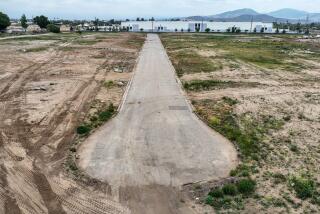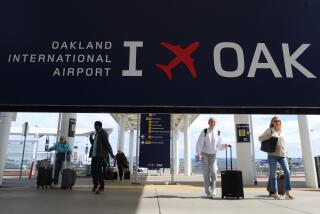Zoning Law Restricting Airport Overturned : Rulings: A judge sides with the Burbank facility, clearing the way for a taxiway extension, despite protests by L.A. Councilman Joel Wachs.
- Share via
A federal judge gave Burbank Airport a victory Monday in its latest skirmish with the city of Los Angeles, slapping down a city zoning law and clearing the way for construction of a 2,000-foot taxiway extension.
U.S. District Judge Manuel Real issued his ruling after a hearing that lasted less than five minutes.
The ruling quashed an apparent bid by the city to acquire power to intervene in the Burbank-Glendale-Pasadena Airport’s plans to build a new and larger passenger terminal, possibly resulting in an increase in air traffic over the east San Fernando Valley.
“The judge would probably think differently if he lived under the flight pattern,” Councilman Joel Wachs said after Real’s decision.
Wachs, who represents neighbors of the airport in their long-running battle over aircraft noise, authored the zoning law struck down by Real.
A 54-acre corner of the airport, which is located mostly in Burbank, extends over the city limit into Los Angeles.
City officials had sought authority through the zoning law to approve any development on that land, denying that this authority would be used to interfere with how the airport is operated.
But Real agreed with Burbank Airport attorney Richard Simon that the city’s true motive was to affect the operations of the airport, which would usurp the authority of the Federal Aviation Administration in violation of the federal supremacy clause of the U.S. Constitution.
Simon argued in court papers that the zoning law was “intended to make . . . the Taxiway ‘B’ project a hostage, in the city’s acknowledged efforts to impose operational and noise controls on an airport that it does not own.”
During his brief remarks from the bench, Real quipped that if the city wanted to improve its chances in court, Wachs “should keep his mouth shut.” The judge was referring to statements by a former Wachs aide who testified before the city’s Planning Commission that the zoning law was needed to give the city “control” over the airport.
Monday’s defeat was part of a long string of disappointments the city has suffered in trying to gain some authority over the airport.
“But it would be wrong not to try,” Wachs said. “If we don’t succeed with this, we’ll try another way.”
For years, the city and homeowner groups have fought fiercely with the airport about noise. Residents’ fears increased when the airport announced plans for a new terminal, which neighbors said will add to the airport’s capacity and mean additional noise and pollution.
In April, the Burbank-Glendale-Pasadena Airport Authority, the airport’s governing body, voted to begin an environmental assessment of plans for a new terminal. This is the third time the authority has begun such a review in the past six years.
The authority’s “preferred location” for the facility is on the so-called Skunk Works property of Lockheed Aircraft in the northeast portion of the airport. The Skunk Works is a nickname given to the site of numerous top-secret projects by Lockheed for the Defense Department, including development of the U-2 spy plane.
Simon later said outside the courtroom that he did not expect the city of Los Angeles to appeal Real’s ruling. “I think this case is over,” he said.
Airport spokesman Victor Gill said that the taxiway construction project would start within “a day or two.”
Because the taxiway project will take only a few months to complete, an appeal “may be moot,” because the work would be completed by the time it could be heard, said Deputy City Atty. Gwen Poindexter.
Airport officials plan to build a 2,000-foot extension to the existing taxiway that serves the west side of the north-south runway, which they said will enhance safety and actually reduce noise.
Aircraft housed on the west side of the runway now must cross the runway to Taxiway A, which parallels the runway on the east, to get to the end of the runway to begin takeoffs. The danger of crossing the runway would be eliminated by a full-length taxiway on the west, airport officials have said.
In addition, aircraft entering the runway from the short Taxiway B often take off from that intersection instead of from the head of the runway, resulting in planes flying lower over neighboring homes and increasing noise, airport officials have said.
Wachs, however, has said he does not believe the new taxiway will help curtail noise. “If this is such a good idea, why are they trying to hide it from public review?” he said.
More to Read
Sign up for Essential California
The most important California stories and recommendations in your inbox every morning.
You may occasionally receive promotional content from the Los Angeles Times.










